Promoting Tourism NCERT Solutions | Communicative English for Class 10 PDF Download
Textual Exercises
Discuss in groups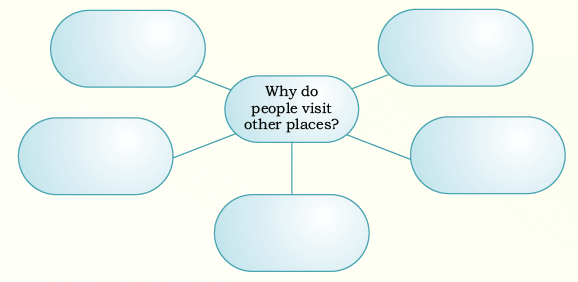
- What is tourism?
- Why do tourists visit a place?
- Do you think Indian tourists and foreign tourists visit places for the same reasons?
- Share your views with your class.
D1. Read the following article about promoting tourism in India.
The new tourist is Indian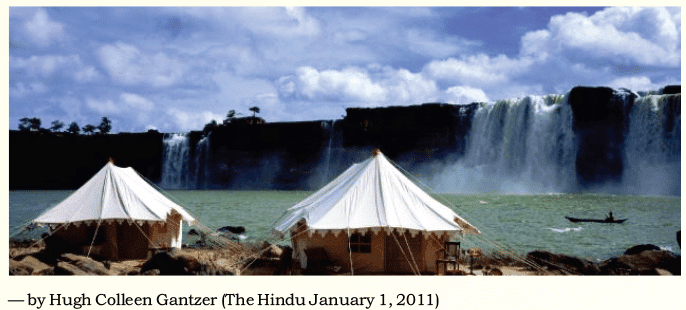 1. If India wants to make it to the top 10 in the international tourism market, then it will further have to revamp its strategies and re-woo its tourists. Today, the need is to highlight the potential areas within the country and court the new tourist.
1. If India wants to make it to the top 10 in the international tourism market, then it will further have to revamp its strategies and re-woo its tourists. Today, the need is to highlight the potential areas within the country and court the new tourist.
2. "Indian tourism will soar by 15 to 20%" said Rajji Rai, President of the 2448 member Travel Agents Association of India. TAAI's interests lie in handling both visitors crossing international borders as well as the growing ranks of Indians travelling around India. This distinction between foreign and domestic tourists is important.
3. Judging by published statistics earlier, our efforts to attract foreign tourists had been consistently unsuccessful. Both Malaysia and China entered the international tourism market decades after we did. In 2009, Malaysia was ranked ninth with 23.6 million foreign arrivals. In the same year, China was ranked 4th with 50.9 million visitors. India did not appeared in the first 10 because it just managed to attract less than 10 million tourists.
Future, tense?
4. All of which begs the question "What makes the Tourism Industry take a rosy view of the future?" It does so because it has realised that it had been courting the wrong tourist. No longer must it run after the brash, demanding, camerabedecked foreigner trickling in from recession-hit economies.
5. The New Tourist is the well-heeled, tolerant, eager Indian: keen to discover India, impatient to go abroad.
6. Mining this market are former Travel Corporation of India employees now in Trail Blazer Tours. According to its brisk and affable CEO, Homa Mistry, in the three brief years of their existence, they had doubled their business every year particularly to the new markets of China, Russia and South America. Indian travellers are now also signing up for cruises to exotic destinations in sybaritic comfort.
7. Karnataka, too, had been quick to assess that the rapidly changing demographics of India had blurred the line between the assumed needs of foreign tourists and those of our domestic ones. The state's glamorous Golden Chariot Tourist train, designed for foreigners, now also does a shorter Jewel of the South tour for uppermiddle-class Indian tourists. To quote Vinay Luthra, the MD of the Tourism Development Corporation, "Money does not seem to be a constraint with domestic tourists interested in the Golden Chariot."
8. The state's very successful, and luxury class, Jungle Lodges and Resorts had, however, created a no-frills clone in their Jungle Camps and Trails for a younger clientele, tapping the growing ranks of junior executives still low on the corporate totem pole. Karnataka had, thus, broadened the base of its domestic tourism market and set another bench-mark.
9. So, too, has Kerala. Kerala's God's Own Country campaign had been clearly designed for the foreign market. But now, Dr. Venu, the then Kerala's Secretary, Tourism and Culture, had deliberately shifted his focus. It is to be noted that in '06-07 Kerala targeted 60% international and 40% domestic, and allocated their tourism resources accordingly. But then it was reversed. By organising Partnership Meets between Kerala's tourism stakeholders and tourism professionals in non-metro cities all around India, Kerala managed, very successfully, to bypass the slump felt by states dependent on international visitors. "We provide a strictly Business to Business platform in the cities we visit. It's been very successful: our tourism figures have grown while those of states dependent on the fickle, demanding, overseas market have remained static," Venu said.
10. This was, logically, a good strategy. In 2009, when we had received 5.11 million foreign tourists, 11.07 million Indians went to tourist destinations outside India. If our Union Ministry of Tourism continues to concentrate on improving facilities for the domestic traveller, the outflow of tourists and rupees will diminish. Enhanced infrastructure such as roads, airports, hygiene, is also attracting more international visitors.
11. Madhya Pradesh saw this writing on the wall years ago. Its brilliant Heart of India campaign and finger-shadows version, overseen by its former Executive Director, Guru Chahal, targeted the domestic traveller. Hari Ranjan Rao, the then MD of the MPTDC had said: "We have the attractions. When we have the infrastructure.. a good network of roads, for instance… domestic tourists will flock in. The others will follow."
12. According to the authoritative trade publication, TravBiz Monitor, the States and Union Territories reported that more than 650 million domestic tourists had visited them in 2009. Contrast that with the insignificant 5.11 million foreign tourists we managed to attract in the same year. Clearly Tourism, like Charity, begins at home.
D2. Based on your reading of the article above, answer the following questions:
1. What evidence does the author provide to support his view that our efforts to attract foreign tourists have been unsuccessful?
2. What, according to you, may be the reasons for such a bleak scenarao?
3. What is the shift in tourism policy recommended by the author? What are his arguments for such a shift?
4. What are the two initiatives taken by Karnataka that signify marked change in its marketing strategy?
5. Why have Kerala's tourism figures grown while those of some other states have remained static?
6. Why does the author say that we should now make efforts to attract ther domestic traveller? What are the areas that we should focus on to achieve it?
7. Why does the author say, "Clearly Tourism, like Charity, begins at home?"
Ans:
1. Our efforts to attract foreign tourists have been constantly unsuccessful. The evidence is that Malaysia and China entered the tourism market much after India. But in 2009. Malaysia had 23.6 million foreign arrivals and China 50.9 million. On the other hand, India had just 5.1 million tourists.
2. The reason for this bleak scenario is that India has been courting the wrong tourist. We have been running after aggressive looking foreign tourists who come in small number. Their own countries are hit by recession. They are very demanding too. We have not been trying to get tourists from countries such as China, Russia and South America.
3. The author recommends the shift. He wants to give more importance to the domestic tourist. He cites Homa Mistry’s (CEO of Travel Corporation of India) efforts. Homa Mistry doubled the business from the new markets of China, Russia and South America and of course the domestic tourists.
4. Karnataka has effected the change too. Formerly the state of Karnataka ran Golden Chariot Tourist train for foreigners only. Now it runs Jewel of the South tour for well- off Indian tourists also. Karnataka has another attraction for rich and young Indian tourists. It is Jungle Camps and Trails. It is a new version of Jungle Lodges and Resorts which were made for the foreigners. These two things signify a marked change in Karnataka’s marketing strategy.
5. Kerala’s tourism figures have grown while those of some other states have remained static. This has happened because Kerala’s Tourism secretary, Dr. Venu has shifted his focus. In 2006-07, Kerala targeted 60% international and 40% domestic tourists. He allocated the state’s tourism resources accordingly. He organised partnership meets in non-metro cities all around India. These meets were between the tourism professionals of Kerala and those cities. The result was that the tourism figures in Kerala grew while they remained unchanged in many states. These were the states which still depended on small and uncertain foreign market.
6. The author gives arguments in support of his contention. The contention is that greater emphasis should be laid to attract domestic tourists. In 2009 India received 5.11 million foreign tourists. On the other hand, more than 11 million Indians went as tourists to foreign markets. If we concentrate on improving facilities for the domestic tourist, the outflow of Indian tourists and rupees will reduce. Better infrastructure such as roads, airports, hygiene will also attract more international visitors. So these are the areas we should focus on.
7. The author says that tourism like charity begins at home. He means that first we should create tourist facilities for the domestic tourist. Madhya Pradesh is one of those states which realised this truth early. Their ‘Heart of India’ campaign and its current version targeted the domestic traveller. So the domestic tourist flocked to Madhya Pradesh and the others followed.
D3. Find words or phrases from the passage that mean the same as the following.
(a) to renovate, redo, or revise (paragraph 1)
(b) trying to win the favor, preference, or goodwill of (paragraph 1)
(c) come in small numbers (paragraph 4)
(d) well-off; rich (paragraph 5)
(e) friendly (paragraph 6)
(f) wanting or enjoying expensive pleasures (paragraph 6)
Ans:
(a) → Revamp
(b) → Re-woo
(c) → Trickling
(d) → Well-heeled
(e) → Affable
(f) → Sybaritic.
D4. Imagine that you are the Director of the Department of Tourism of the State of Palwal Pradesh. You have recently received the following letter from the Minister of Tourism.
GOVERNMENT OF PALWAL PRADESH
Ministry of Tourism
13 May 20xx
Director of Tourism
121 Janta Avas Gri
Anandpur, Palwal Pradesh
Subject-
Dear…
As you are aware, local and international tourism is becoming increasingly important to Palwal Pradesh. It is now a major employer, and a significant means of earning foreign exchange. I am therefore anxious to promote and develop the State's tourism industry.
I should like you to study the present trends in tourism and write me a report on their main features, with projections for ten years' time. I should also like to receive your recommendations on certain matters. Specifically, your report should deal with the following: Origin of Tourists: Where are they from - India and/ or foreign countries?
What do you predict will be the figures in 10 years' time?
What action do you recommend?
I look forward to receiving your report.
Yours sincerely
Signature
(Krishna Mathur)
Minister of Tourism
Ans: Please read the letter carefully. It will help us in answering question no. 5.
D5. In section D.6 you will write the report asked for. First though, it is necessary to study the following statistics and draw appropriate conclusions. Work in groups of four. Discuss the three figures in this section and the questions that follow each figure, and write notes to answer those questions. (Contrary to the recent trends, foreign tourists visiting Palwal Pradesh outnumber domestic tourists).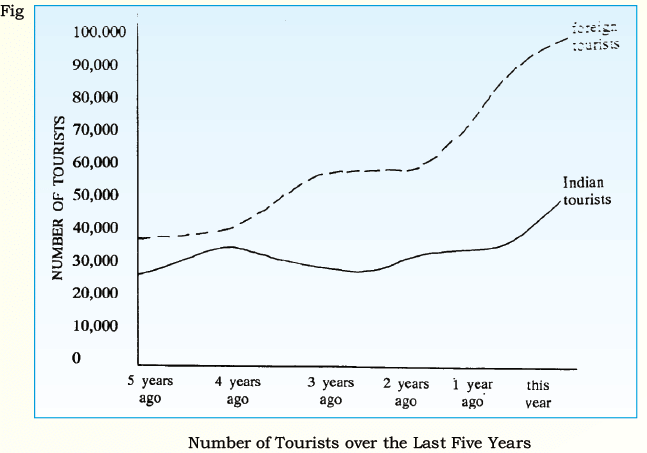 1. What has been the general trend in the number of tourists visiting Palwal Pradesh over the last five years?
1. What has been the general trend in the number of tourists visiting Palwal Pradesh over the last five years?
2. Which groups have shown increases, and by how much?
3. Suggest reasons for the changes over the last five years, for both groups of tourists.
Ans:
1. The general trend in the number of tourists has been that the number of tourists, both Indian and foreigners, has been increasing.
2. Foreign tourists have shown more increases. Their number during the last five years has increased from 40000 to 1,00,000.
3. The chief reasons for the changes are :
I. Foreign Tourists :
(a) The Government has exposed the country’s tourist spots very favourably. This has attracted a large number of foreign tourists to visit India.
(b) There is now an increased awareness of our country as a tourist destination in the foreign countries. Due to this the tourists want to know more about India and its age-old culture.
(c) An increased number of five and four-star hotels and other good quality hotels— both private and Government—have come out at the tourist spots during the last decade.
(d) Many reputed Travel Agencies have also sprung up. They have a contact with their counterparts in other countries. They take every care to make the visit of the foreign tourists comfortable by arranging package tours.
II. Indian Tourists :
(a) At local level there has grown a public awareness for tourism within the country. Consequently, many middle class families have started local sight-seeing.
(b) Various government schemes like Leave Travel Concession to govt, employees, subsidized and concessional travel to students etc, for educational tours have contributed to the increase of tourists.
(c) Improvement in the standard of living is also a positive factor in this direction. It has definitely boosted tourism.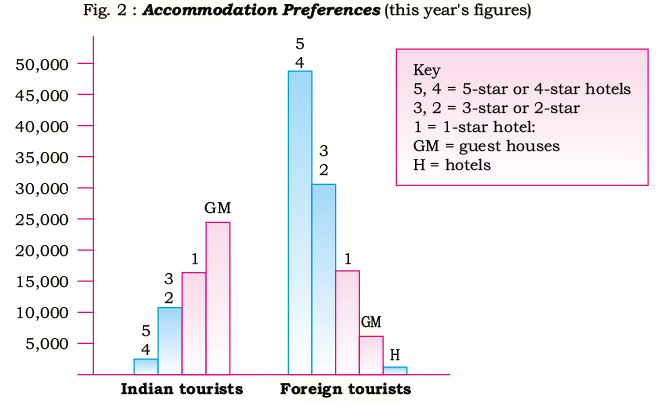 1. For each group of tourists, which is the most popular type of accommodation ?
1. For each group of tourists, which is the most popular type of accommodation ?
2. How many tourists of each group stayed in these most popular types of accommodation ?
3. Suggest why different types of accommodation are popular with different types of tourists.
Ans:
1. For Indian tourists guest houses are the most popular type of accommodation. For foreign tourists 5 and 4 star hotels are the most popular type of accommodation.
2. 25000 Indian tourists stayed in the guest houses. 47000 foreign tourists stayed in 5 and 4 star hotels.
3. Guest houses are popular with Indian tourists because of two reasons. First, they are affordable. Secondly, the atmosphere and the fobd are to their taste.
Four and five star accommodation is popular with the foreigners because this caters to their different needs. Besides the modern facilities, these hotels provide each foreigner the food of his/her choice.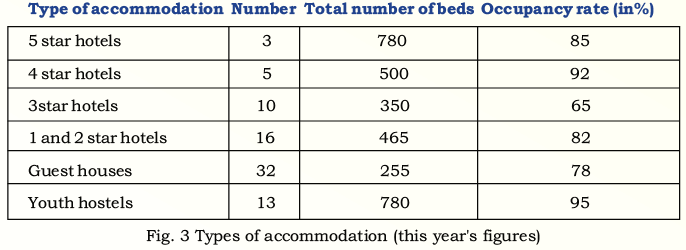 1. What does the final column mean ? Why is it important ?
1. What does the final column mean ? Why is it important ?
2. There are three 5 star hotels and 13 youth hostels, yet each type of accommodation has the same number of beds. Explain.
3. Which are the two most popular types of accommodation ?
4. Which types of accommodation have occupancy rates of 85% or over ?
Ans:
1. The final column shows how far the available accommodation is being used. So it gives us valuable information. It is important when we plan to create additional accommodation. We should first create the type of accommodation which is much in demand.
2. It means that a 5 star hotel has at an average 260 beds. On the other hand, a youth hostel has at an average only 60 beds.
3. The two most popular types of accommodation are the 5 star hotels and youth hostels.
4. 5-star hotels, 4-star hotels and youth hostels have occupancy rates of 85% or over.
D6. Work with a partner to write the report asked for in D.4. You are the Director of Tourism for Palwal Pradesh. Make sure that ……
- you answer all the questions raised by the Minister.
- you quote from the statistics in Q.4 to support the points you make.
- you follow the report format and style in Q.6 below.
- you use the language advice given in Q.7 below.
- First study Q.6 and Q.7. Then (working in pairs) write your report.
D7. Report
From : Shankar Murti, Director of Tourism, Palwal Pradesh
To : Minister of Tourism, Palwal Pradesh
Date : 3 March, 20 – –
A study of the present trends of tourism in Palwal Pradesh, their main features and projections for 10 years’ time
Sir
The following are our findings and suggestions.
1. Current trends : The current trends show that the number of foreign tourists visiting Palwal Pradesh has been constantly increasing. It has increased from 40000 to 1,00,000 in the last five years. On the other hand the number of Indian tourists has been rising and falling. During that same five year’s time, their number has increased from 25000 to about 50000.|
1.1. Origin of tourists : So the trend suggests that most of the tourists to Palwal Pradesh are of foreign origin.
1.2. Accommodation : Currently, there seems to be just enough accommodation for both types of tourists. The preferred destination of the foreign tourist has mainly been 5 star and 4 star hotels. Of the 780 beds available in five star hotels, the occupancy rate has been 85% while of the 400 beds of 4 star hotels, it has been 92%. For the domestic tourist, the preferred accommodation has been youth hostels and 1 star hotels.
This is hardly surprising because domestic tourists cannot afford luxury accommodation. They prefer to spend less on accommodation.
2. Predictions for 10 years in the Future :
2.1. Origin of Tourists : The indications are that the number of foreign tourists may go up to 6 lac by the end of the next ten years. If the present trend continues, the number of domestic tourists may rise to one lac.
2.2. Accommodation : Palwal Pradesh has to increase the accommodation. The biggest increase is needed in the number of 4 star hotels. Their number must increase from the present no. 5 to 30-35 in ten years. The number of 5 star hotels should increase from 3 to 18-20. 1, 2 and 3 star hotels are being taken by both groups of tourists. So their number should increase in the same proportion ie, about 6 times each. The same thing is true of guest houses. However, the greatest need is to increase the number of youth hostels which should be increased from 13 to 32.
3. Recommendations : There has been a steady rise in the number of foreign tourist. So special attention should be given to create facilities for them.
To attract the domestic tourists, more youth hostels and single star accommodation be created.
I am confident of a good tourism future of Palwal Pradesh.
(Signature)
(Shankar Murti)
Director of Tourism
Palwal Pradesh
D8. In your written report, you will find the following language useful: when describing trends and changes
Ans: No question asked.
D9. A Final Check…..
Before you hand in your report:
1. Have you answered all the questions in the Minister's letter in D.4?
2. Have you proof-read your report for accuracy in grammar, spelling and punctuation?
3. Is your report written in a simple, easy-to-read, interesting style?
4. Have you asked a classmate to read your report, and give you feedback on it?
|
8 videos|250 docs|8 tests
|
FAQs on Promoting Tourism NCERT Solutions - Communicative English for Class 10
| 1. What are the key benefits of promoting tourism in India? |  |
| 2. How does tourism impact the environment in India? |  |
| 3. What are some popular tourist destinations in India? |  |
| 4. How can local communities benefit from tourism? |  |
| 5. What role does the government play in promoting tourism in India? |  |















